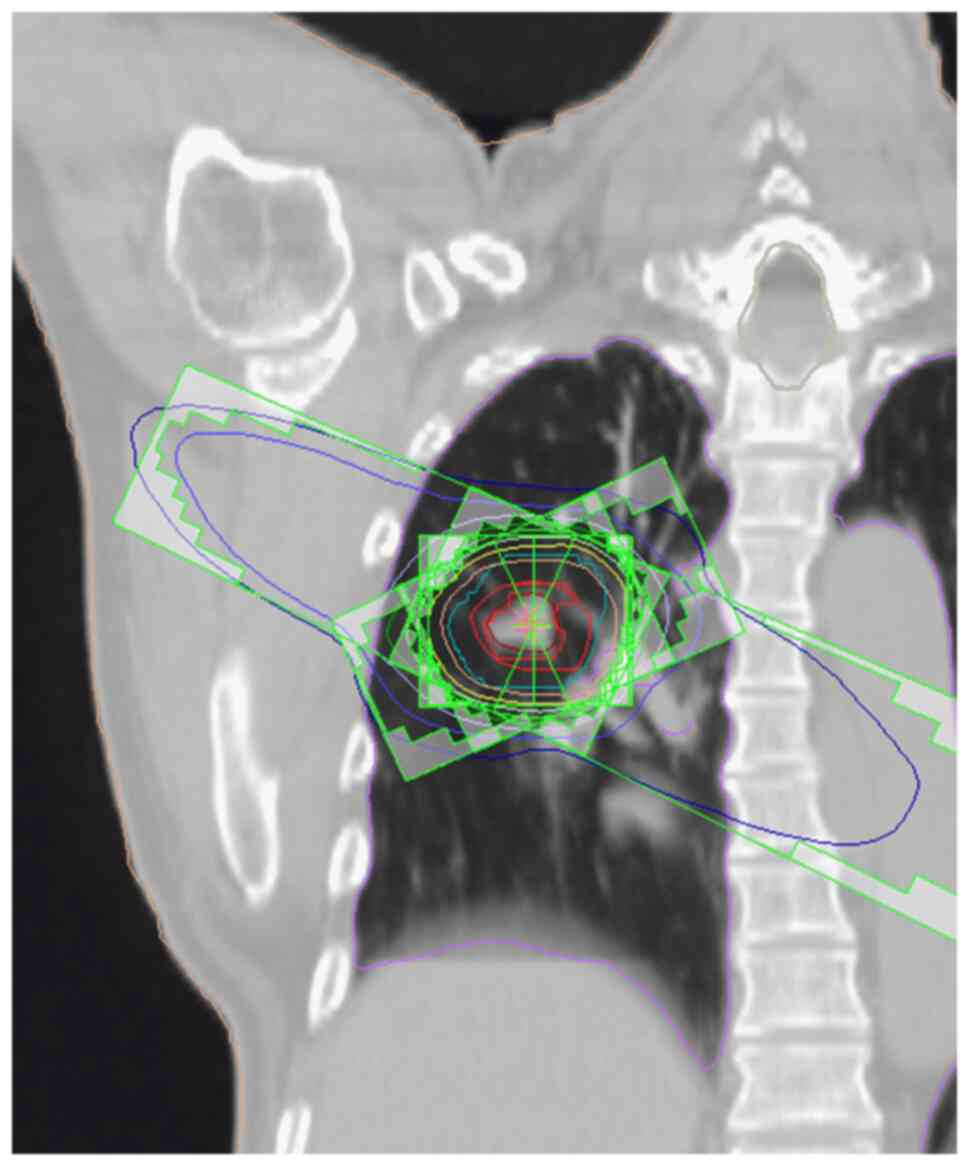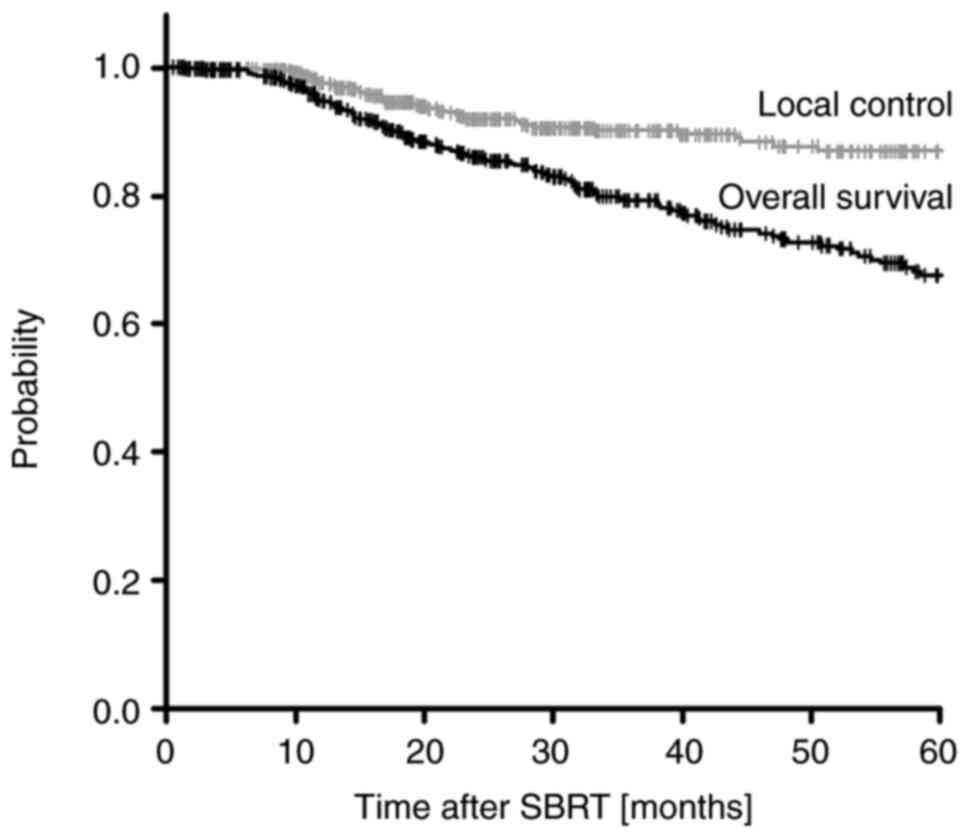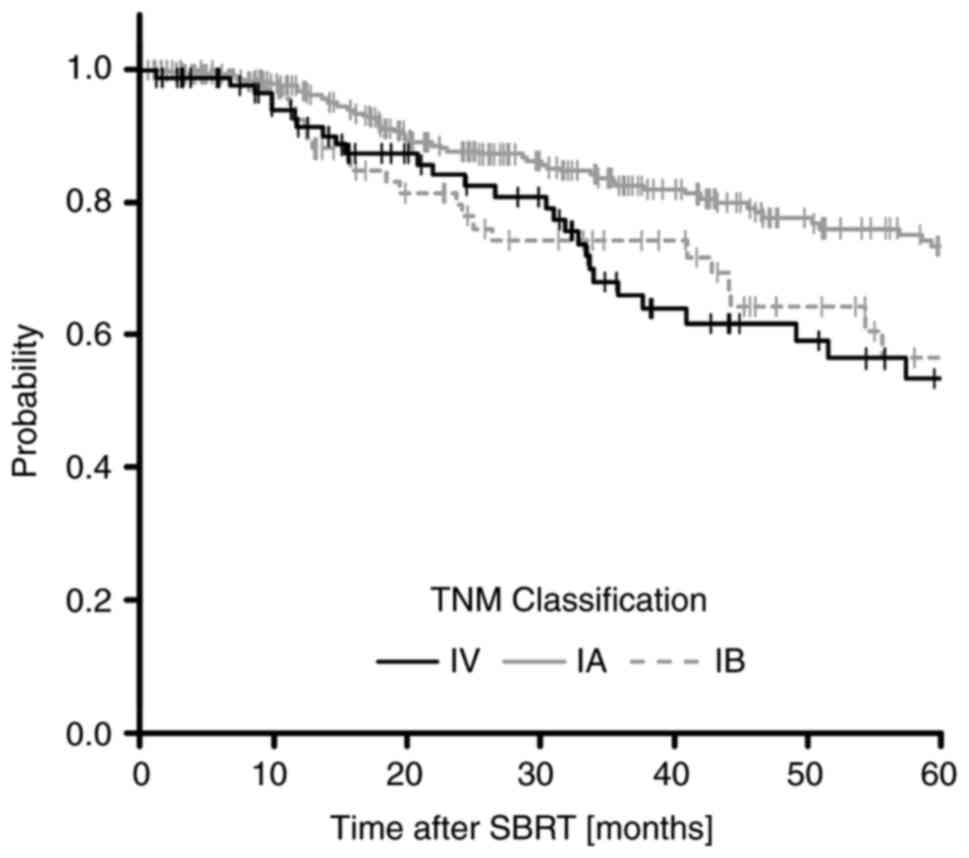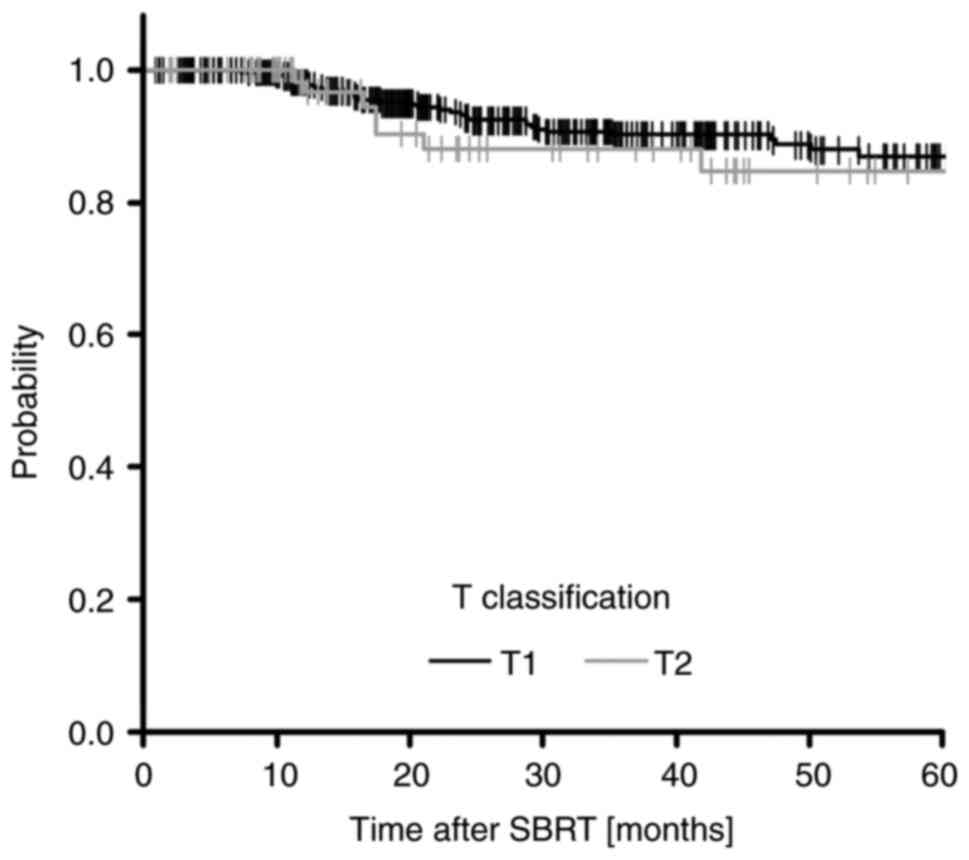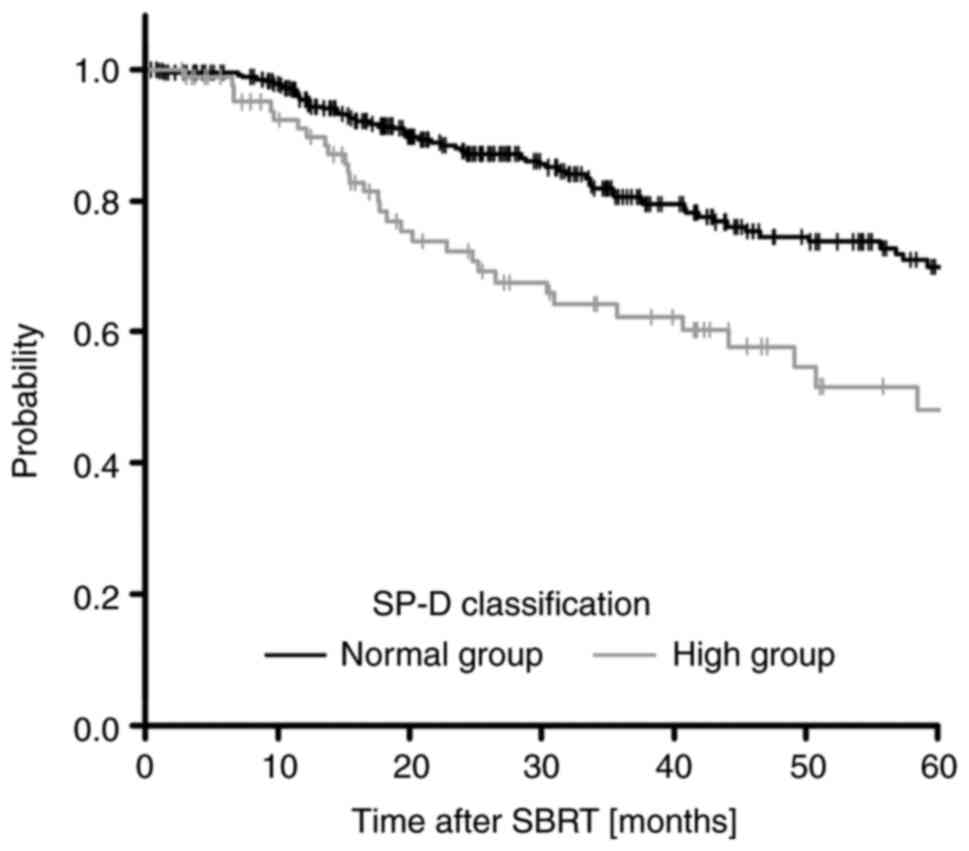|
1
|
Nagata Y and Kimura T: Stereotactic body
radiotherapy (SBRT) for stage I lung cancer. Jpn J Clin Oncol.
48:405–409. 2018. View Article : Google Scholar : PubMed/NCBI
|
|
2
|
Onishi H, Shirato H, Nagata Y, Hiraoka M,
Fujimoto M, Gomi K, Harsawa K, Hayakawa K, Niibe Y, Takai Y, et al:
Stereotactic body radiotherapy (SBRT) for operable stage I
non-small-cell lung cancer: Can SBRT be comparable to surgery? Int
J Radiat Oncol Biol Phys. 81:1352–1358. 2011. View Article : Google Scholar : PubMed/NCBI
|
|
3
|
Palma D, Visser O, Lagerwaard FJ,
Belderbos J, Slotman B and Senan S: Treatment of stage I NSCLC in
elderly patients: A population-based matched-pair comparison of
stereotactic radiotherapy versus surgery. Radiother Oncol.
101:240–244. 2011. View Article : Google Scholar : PubMed/NCBI
|
|
4
|
Bei Y, Murakami N, Nakayama Y, Okuma K,
Kashihara T, Raturi VP, Okamoto H, Takahashi K, Inaba K, Igaki H
and Itami J: Stereotactic body radiation therapy for early-stage
non-small-cell lung cancer in octogenarians and older: An
alternative treatment. J Radiat Res. 61:586–593. 2020. View Article : Google Scholar : PubMed/NCBI
|
|
5
|
Dupic G, Biau J, Molnar I, Chassin V,
Dediue V, Lapeyre M and Bellière-Calandry A: Significant
correlation between overall survival and mean lung dose in lung
stereotactic body radiation therapy (SBRT). Front Oncol.
10:15772020. View Article : Google Scholar : PubMed/NCBI
|
|
6
|
Yamamoto T, Jingu K, Shirata Y, Koto M,
Matsushita H, Sugawara T, Kubozono M, Umezawa R, Abe K, Kadoya N,
et al: Outcomes after stereotactic body radiotherapy for lung
tumors, with emphasis on comparison of primary lung cancer and
metastatic lung tumors. BMC Cancer. 14:4642014. View Article : Google Scholar : PubMed/NCBI
|
|
7
|
Aoki M, Hatayama Y, Kawaguchi H, Ichise K,
Hirose K and Takai Y: Measurements of substance densities of
non-small cell lung cancer using dual energy computed tomography
are useful for prediction of local control and overall survival
after stereotactic body radiation therapy. Astro. 102:e6712018.
|
|
8
|
Grills IS, Hope AJ, Guckenberger M, Kestin
LL, Werner-Wasik M, Yan D, Sonke JJ, Bissonnette JP, Wilbert J,
Xiao Y and Belderbos J: A collaborative analysis of stereotactic
lung radiotherapy outcomes for early-stage non-small-cell lung
cancer using daily online cone-beam computed tomography
image-guided radiotherapy. J Thorac Oncol. 7:1382–1393. 2012.
View Article : Google Scholar : PubMed/NCBI
|
|
9
|
Chang JY, Liu H, Balter P, Komaki R, Liao
Z, Welsh J, Mehran RJ, Roth JA and Swisher SG: Clinical outcome and
predictors of survival and pneumonitis after stereotactic ablative
radiotherapy for stage I non-small cell lung cancer. Radiat Oncol.
7:1522012. View Article : Google Scholar : PubMed/NCBI
|
|
10
|
Takeda A, Yokosuka N, Ohashi T, Kunieda E,
Fujii H, Aoki Y, Sanuki N, Koike N and Ozawa Y: The maximum
standardized uptake value (SUVmax) on FDG-PET is a strong predictor
of local recurrence for localized non-small-cell lung cancer after
stereotactic body radiotherapy (SBRT). Radiother Oncol.
101:291–297. 2011. View Article : Google Scholar : PubMed/NCBI
|
|
11
|
Hamamoto Y, Kataoka M, Yamashita M, Nogami
N, Sugawara Y, Kozuki T, Sawada S, Suehisa H, Shinohara S, Nakajim
N and Shinkai T: Factors affecting the local control of
stereotactic body radiotherapy for lung tumors including primary
lung cancer and metastatic lung tumors. Jpn J Radiol. 30:430–434.
2012. View Article : Google Scholar : PubMed/NCBI
|
|
12
|
Dunlap NE, Larner JM, Read PW, Kozower BD,
Lau CL, Sheng K and Jones DR: Size matters: A comparison of T1 and
T2 peripheral non-small-cell lung cancers treated with stereotactic
body radiation therapy (SBRT). J Thorac Cardiovasc Surg.
140:583–589. 2010. View Article : Google Scholar : PubMed/NCBI
|
|
13
|
Bral S, Gevaert T, Linthout N, Versmessen
H, Collen C, Engels B, Verdries D, Everaert H, Christian N, De
Ridder M and Storme G: Prospective, risk-adapted strategy of
stereotactic body radiotherapy for early-stage non-small-cell lung
cancer: Results of a Phase II trial. Int J Radiat Oncol Biol Phys.
80:1343–1349. 2011. View Article : Google Scholar : PubMed/NCBI
|
|
14
|
Aoki M, Hirose K, Sato M, Akimoto H,
Kawaguchi H, Hatayama Y, Fujioka I, Tanaka M, Ono S and Takai Y:
Prognostic impact of average iodine density assessed by dual-energy
spectral imaging for predicting lung tumor recurrence after
stereotactic body radiotherapy. J Radiat Res. 57:381–386. 2016.
View Article : Google Scholar : PubMed/NCBI
|
|
15
|
Tanaka M, Ichise K, Fujioka I, Sato M,
Hirose K, Kawaguchi H, Hatayama Y, Takai Y, Tsushima E and Aoki M:
Impact of low iodine density tumor area ratio on the local control
of non-small cell lung cancer through stereotactic body
radiotherapy. J Radiat Res. 62:448–456. 2021. View Article : Google Scholar : PubMed/NCBI
|
|
16
|
Yamashita H, Kobayashi-Shibata S, Terahara
A, Okuma K, Haga A, Wakui R, Ohtomo K and Nakagawa K: Prescreening
based on the presence of CT-scan abnormalities and biomarkers (KL-6
and SP-D) may reduce severe radiation pneumonitis after
stereotactic radiotherapy. Radiat Oncol. 5:322010. View Article : Google Scholar : PubMed/NCBI
|
|
17
|
Aoki M, Hatayama Y, Kawaguchi H, Hirose K,
Sato M, Akimoto H, Miura H, Ono S and Takai Y: Stereotactic body
radiotherapy for lung metastases as oligo-recurrence: A single
institutional study. J Radiat Res. 57:55–61. 2016. View Article : Google Scholar : PubMed/NCBI
|
|
18
|
Aoki M, Abe Y, Kondo H, Hatayama Y,
Kawaguchi H, Fujimori A, Suzaki K, Seino M, Morita T, Souma M, et
al: Clinical outcome of stereotactic body radiotherapy of 54 Gy in
nine fractions for patients with localized lung tumor using a
custom-made immobilization system. J Radiat Res. 25:289–294.
2007.PubMed/NCBI
|
|
19
|
Kanda Y: Investigation of the freely
available easy-to-use software ‘EZR’ for medical statistics. Bone
Marrow Transplant. 48:452–458. 2013. View Article : Google Scholar : PubMed/NCBI
|
|
20
|
Sasaki R, Soejima T, Matsumoto A, Maruta
T, Yamada K, Ota Y, Kawabe T, Nishimura H, Sakai E, Ejima Y and
Sugimura K: Clinical significance of serum pulmonary surfactant
proteins A and D for the early detection of RP. Int J Radiat Oncol
Biol Phys. 50:301–307. 2001. View Article : Google Scholar : PubMed/NCBI
|
|
21
|
Miyazaki T, Yamazaki T, Nakamura D, Sato
S, Yamasaki N, Tsuchiya T, Matsumoto K, Kamohara R, Hatachi G and
Nagayasu T: Surgery or stereotactic body radiotherapy for elderly
stage I lung cancer? A propensity score matching analysis. Surg
Today. 47:1476–1483. 2017. View Article : Google Scholar : PubMed/NCBI
|
|
22
|
Chong IW, Chang MY, Chang HC, Yu YP, Shue
CC, Tsai JR, Hung JY, Chou SH, Tsai MS, Hwang JJ and Lin SR: Great
potential of a panel of multiple hMTH1, SPD, ITGA11 and COL11A1
markers for diagnosis of patients with non-small cell lung cancer.
Oncol Rep. 16:981–988. 2006.PubMed/NCBI
|
|
23
|
Yamashita H, Takahashi W, Haga A and
Nakagawa K: Radiation pneumonitis after stereotactic radiation
therapy for lung cancer. World J Radiol. 6:708–715. 2014.
View Article : Google Scholar : PubMed/NCBI
|
|
24
|
Matsuno Y, Satoh H, Ishikawa H, Kodama T,
Ohtsuka M and Sekizawa K: Simultaneous measurements of KL-6 and
SP-D in patients undergoing thoracic radiotherapy. Med Oncol.
23:75–82. 2006. View Article : Google Scholar : PubMed/NCBI
|
|
25
|
Takahashi H, Imai Y, Fujishima T,
Shiratori M, Murakami S, Chiba H, Kon H, Kuroki Y and Abe S:
Diagnostic significance of surfactant proteins A and D in sera from
patients with radiation pneumonitis. Eur Respir J. 17:481–487.
2001. View Article : Google Scholar : PubMed/NCBI
|
|
26
|
Yamazaki H, Aibe N, Nakamura S, Sasaki N,
Suzuki G, Yoshida K, Yamada K, Koizumi M, Arimoto T, Iwasaki Y, et
al: Measurement of exhaled nitric oxide and serum surfactant
protein D levels for monitoring radiation pneumonitis following
thoracic radiotherapy. Oncol Lett. 14:4190–4196. 2017. View Article : Google Scholar : PubMed/NCBI
|
|
27
|
Umeda Y, Hasegawa Y, Otsuka M, Ariki S,
Takamiya R, Saito A, Uehara Y, Saijo H, Kuronuma K, Chiba H, et al:
Surfactant protein D inhibits activation of non-small cell lung
cancer-associated mutant EGFR and affects clinical outcomes of
patients. Oncogene. 36:6432–6445. 2017. View Article : Google Scholar : PubMed/NCBI
|















